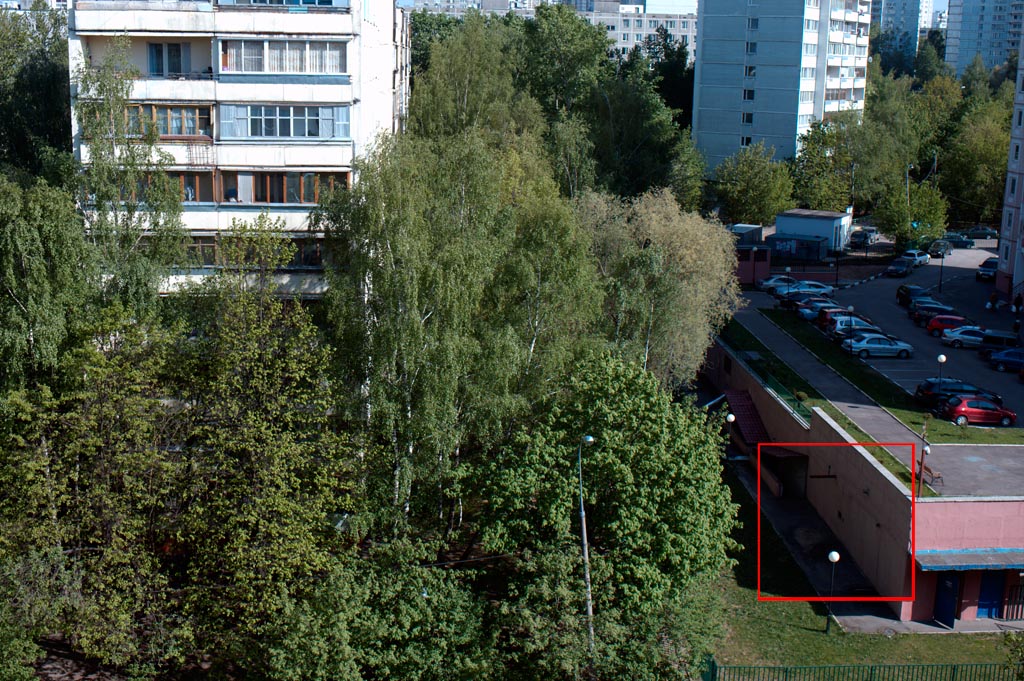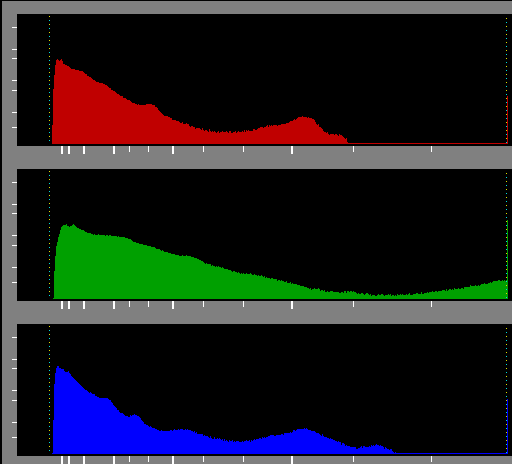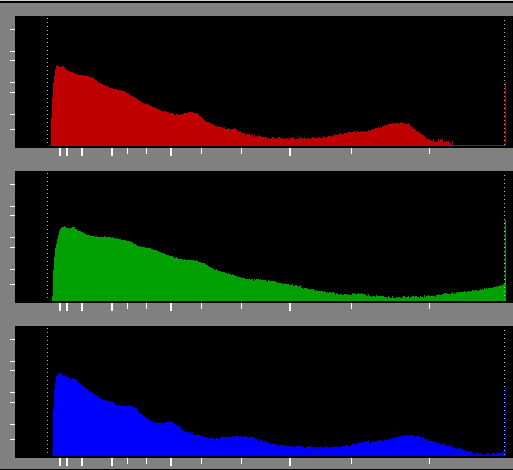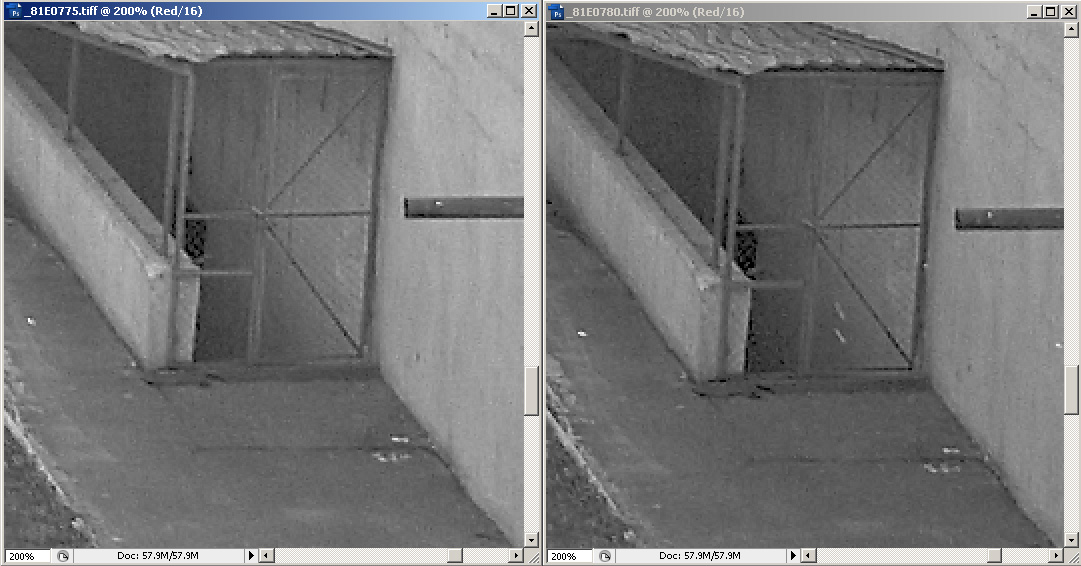 In the previous article and during lengthy discussions on various forums, we promised to demonstrate the usefulness of magenta filters. Those filters compensate the imbalance between the sensitivities of color channels in digital cameras. Promises should be fulfilled, and having this filter, it takes nearly no time to prepare the demonstration given that you have that sunlight...
In the previous article and during lengthy discussions on various forums, we promised to demonstrate the usefulness of magenta filters. Those filters compensate the imbalance between the sensitivities of color channels in digital cameras. Promises should be fulfilled, and having this filter, it takes nearly no time to prepare the demonstration given that you have that sunlight...
The Test Shot
 I have already used the view from the balcony of my Moscow apartment as a test scene for quite some years. For different times of the day and during the year I can get very different lighting conditions, from back-lit to the side and front-lit scene. For this case, it was something between the front and side-light, which you can judge by the directions of the shadows.
I have already used the view from the balcony of my Moscow apartment as a test scene for quite some years. For different times of the day and during the year I can get very different lighting conditions, from back-lit to the side and front-lit scene. For this case, it was something between the front and side-light, which you can judge by the directions of the shadows.

 In this experiment, the camera used was a Canon 1D Mk III with a 35/1.4 lens mounted on it. I shot two series of seven frames each. The exposure difference between two consequent frames was 0.3 eV. The first series were shot without the filter, while the second with a Lee gel filter CC30M on the lens. One shot was chosen from each of the series for further analysis. The criteria for the choice was the very start of the clipping in the green channel.
In this experiment, the camera used was a Canon 1D Mk III with a 35/1.4 lens mounted on it. I shot two series of seven frames each. The exposure difference between two consequent frames was 0.3 eV. The first series were shot without the filter, while the second with a Lee gel filter CC30M on the lens. One shot was chosen from each of the series for further analysis. The criteria for the choice was the very start of the clipping in the green channel.
As it was expected, the start of the clipping occurred at different exposures.
- For the series without the filter, it was 1/100 s f/8
- For the series with the filter in for of the lens, the clipping started 1/50 s f/8
At a first glance, presuming the filter blocks only the green channel, this means that the red and the blue channels should be exposed one stop better. However, the blue and red channels are sensitive to a pretty wide range of spectrum. That's why the actual per channel exposures were changed less than that, as it is obvious when looking at the white balance coefficients.
- For the shot without the filter, both R and B coefficients are about 2, that is white balancing is equivalent to pushing these channels +1 eV.
- For the shot with the filter, both coefficients were about 1.3, that is about 0.4 eV push for white balancing.
For further analysis we are choosing an area which is marked on the shot with a red rectangle. Raw Photo Processor was used to process the shots. Sharpening and color blurring were switched off. Demosaicing was using the AHD algorithm. As we saw from the prior experiments, this converter is less prone to producing noise.
Noise In the Red Channel
 As it was shown in the previous article, the noise between different channels varies greatly. For daylight, the most noisy one is generally the red channel, and the least noise is found in the green channel. This is clearly visible in the shadows of flat-lit objects even before any post-processing. Post-processing through the increase of contrast and sharpening amplifies this effect and the difference just jumps out at the viewer. For shots of real life, this effect might not be so obvious, however in the neutral areas below the mid-tone like the triangle-shaped area of the mesh fence to the left of the staircase leading down to the basement the effect is visible without any adjustments in post-processing. In this dark triangle, the Standard Deviation in the red channel is 1.4 for the filtered shot, and 1.85 for the unfiltered shot. Given that the channel values are around 22, this is quite a difference.
As it was shown in the previous article, the noise between different channels varies greatly. For daylight, the most noisy one is generally the red channel, and the least noise is found in the green channel. This is clearly visible in the shadows of flat-lit objects even before any post-processing. Post-processing through the increase of contrast and sharpening amplifies this effect and the difference just jumps out at the viewer. For shots of real life, this effect might not be so obvious, however in the neutral areas below the mid-tone like the triangle-shaped area of the mesh fence to the left of the staircase leading down to the basement the effect is visible without any adjustments in post-processing. In this dark triangle, the Standard Deviation in the red channel is 1.4 for the filtered shot, and 1.85 for the unfiltered shot. Given that the channel values are around 22, this is quite a difference.
If one starts to push the shadows from 21-22 to 42-44 and applies slight sharpening (300%, 0.5, threshold 10) he gets something like illustration provided here, where to the left is the crop from the filtered image, while to the right, there is the crop from the image shot without the filter.
Looks like the filter used for this experiment is not strong enough, and the experiments should be repeated with a filter of a higher density, however even with CC30M filter, the difference is quite obvious.
Pro et Contra
As we can see, the filter deprived us of one stop of light, and helped slightly more then half a stop to avoid the imbalance of the channels. It is possible that a filter which will attenuate the light for one and a half stop will improve the situation even further. In other words
- If there is enough light (say when shooting a landscape using a tripod) and the possibility that post-processing of shadow areas is quite possible, the filter will improve the situation.
- If there is not enough light, the filter will make the situation worse.
The price of the solution is about $40 ( gel filter CC30M or CC40M plus Lee Gel Snap Holder). The Gel Snap Holder can be mounted on any lens, with the diameter of up to 82 mm, and on most flashguns. One size fits all.

Comments
magenta filter
what if a manual WB is chosen and a -magenta is entered (i don't think most of calibrated in CC)? will this give a similar result?
for example, Sony will allow such a compensation. i have already, through my raw processing, set this as my standard, as i shot at one temperature with -magenta, and then adjust the proper temperature during raw processing.
The point in using magenta
The point in using magenta filter is to achieve better exposure of red and blue channels by allowing less light to hit the sensors under the green filters of sensor CFA. This is physical, pre-capture filtration; and as such it can't be reproduced by tuning the camera or through post-processing.
--
Iliah Borg
Why not use CC30R instead of M?
A magenta filter will crosstalk more than a red filter, and CC40R or 30R would be easily obtained. Have you tried to make up a filter pack which will equalize the highlight clip position for all three channels in daylight?
Second question - to what extent do you think the IR-cut filters used are attenuating the far end of the red response, and might this be in part responsible for the low red sensitivity?
Magenta is 'Minus Green
Magenta is 'Minus Green filter', but Red is 'Minus Green and Minus Blue'.
In daylight situation CC30M-CC40M produces near perfect sensitivity balance on my cameras.
-- Alex Tutubalin @LibRaw LLC
I realise that, but the blue
I realise that, but the blue channel will not be proportionately affected. A mix of CCR and CCM would be needed to equalise the balance, just wondered in view of the serious effect of red channel noise on blue skies whether CCR might not be a better option.
Some time ago (2-3 years) I did some tests using 80B filters for tungsten, and found that between 1 and 1.5 stops of highlight headroom was recovered by shooting with 80B (based on ACR conversions of the time, KM 7D). Iliah's findings show that maybe ACR was pre-boosting the red channel anyway. A different filter (not 80B) might have enabled equal channel gain in raw conversion. I worked in the 1990s with Leaf and other scanning backs, researching hot mirror filters and light balance filters to recover better colour information.
It surprises me that this kind of work (I'm just a photographer, my wife is a colour scientist) does not seem to have influenced the design of RGB filters for Bayer-type sensors. The sensor itself, unfiltered, is highly sensitive to red. But gradation in the red channel is determined by the blue component more than any other. The work of Dr Andrew Stevens in the early 1990s has also been ignored - he showed very effectively how only two coloured filters were required to produce full colour, not three. Andrew was a colour scientist with Kodak but I don't know where he is now. He was able to produce pseudo-isocolour from a panchromatic film and an orange filter, plus an exposure level - nothing more needed (two exposures)!
David
Sure, pure CC30-40M (for
Sure, pure CC30-40M (for different cameras) balances Green with Blue. Red channel remains half-stop underexposed.
Combination of something like СС30M plus CC15-20R should result in better channel balance in daylight. The cost is extra filter with extra glare (and one more slot in filter holder).
I'll try this combination when Moscow weather become more sunny :)
Filters on sensor is result of some compromise:
* For shooting in tungsten light (espessially, in 'home' bulbs, not high-temperature halogen ones) you need to lower sensitivity of red. If not, then skin tones will be overexposed. Look at the last chapter of my 'White balance problems' article ( http://www.libraw.org/articles/white-balance-in-digital-cameras.html ): green and red (without filters) are near-perfectly balanced under incadescent bulb.
* Also, there is 'High ISO race' now: last Canon/Nikon models have ISO 25600 sensitivity. To lower the signal/noise level, manufactures need to widen filter response curves. And, surely, color characteristics on Canon 5D-2 or Nikon D3 is much worse than on previous generation.
Hope, that 'high color quality' race will start sometime later.....
-- Alex Tutubalin @LibRaw LLC
This is a real dilemma - they
This is a real dilemma - they could make two sensor types, one with narrow-bandpass colour filters, one with broad spectrum RGB. You would end up with a low ISO sensor offering maximum colour discrimination and Delta-E accuracy (but of course the potential for greater Delta-E errors if software conversion was not precisely matched to the transmission curves); and a high ISO sensor where the overlapping curves could reduce colour discrimination, relying on software to restore it.
I always felt that the RGB filters used on the KM7D/5D were narrower in band than the filters used on the same sensor by Nikon (D70 etc), allowing the lower ISO 100 setting and also giving the distinctive colour of the 7D/5D. I have also always thought that Canon's (early) RGB filters must be weak, helping reduce noise but giving a colour quality I never liked as much. The wide gamut captured by Canon models compared to the 7D/5D also points to this - narrow cut filters will, of course, limit the overall gamut but improve discrimination and accuracy within that gamut.
Did you mean green and blue are perfectly balanced in tungsten light, not green and red?
I have a large stock of ex-Minolta 85B (daylight to tungsten) conversion filters here, never been able to sell them. I gave away 200 40.5mm ones last week (40.5mm is not much use!). I may try the 85B in daylight, using the camera's tungsten preset, to see if it has some benefits.
David
As you can see in RAW data
As you can see in RAW data histograms, Green and Red are balanced perfectly (without any filters) in incadescent bulb light. You don't want to use any filters in this low-light condition, anyway.
Also, I don't think that 'gamut' is a good word in describing digital camera. Camera is sensitive to any visible light (to infrared - too), so camera gamut is equal (or broader) to human gamut.
We should describe camera behavior in terms of metamerism: some colors cannot be separated (i.e. same RGB(G) response for different colors)
-- Alex Tutubalin @LibRaw LLC
Magenta
what if a manual WB is chosen and a -magenta is entered (i don't think most of calibrated in CC)? will this give a similar result?
for example, Sony will allow such a compensation. i have already, through my raw processing, set this as my standard, as i shot at one temperature with -magenta, and then adjust the proper temperature during raw processing.
At a first glance, presuming the filter blocks only the green channel, this means that the red and the blue channels should be exposed one stop better. However, the blue and red channels are sensitive to a pretty wide range of spectrum. That's why the actual per channel exposures were changed less than that, as it is obvious when looking at the white balance coefficients.
WB settings does not change
WB settings does not change raw data, so you may use any in-camera setting.
-- Alex Tutubalin @LibRaw LLC